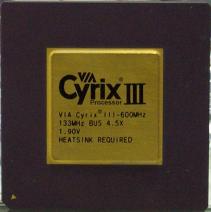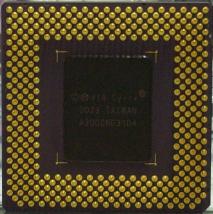VIA Cyrix III 533, 600MHz (2/4)
Posted by Wesley onQuite a few things have been changed to Cyrix since last year and some of them are obvious on the picture above. You can click on the picture for bigger image. First of all, since VIA owns Cyrix now, the company that produces the chip is VIA, and Cyrix is now just the brand of the chip itself. And why is it 'III' when where weren't a 'Cyrix I' or 'Cyrix II' before? It's possibly because the last Cyrix chip was M-II, which is now marketed as 'VIA Cyrix MII'. Also noticeable is the disappearance of the 'PR' speed rating system which followed with Cyrix chips and for a short time, AMD chips. Now Cyrix is 'proudly' showing its true MHz speed. Let's have a look at the chip's features.
| Interface: | Intel's Socket 370 |
| FSB: | 133MHz or 100MHz |
| L1 Cache: | 128KB |
| Inst.Sets: | MMX, 3DNow! |
| Power: | 10W Average |
| Mfg.Process: | 0.18 micron |
| Availablility: | 500, 533, 600MHz |
As you can see, Cyrix III is to be plugged into Socket 370, so it's trying to compete directly with Intel's Celeron processor. This move from aging Socket7(or Super7) to widespread Socket 370 means that Cyrix III may please many users as an upgrade option. Support for MMX and 3DNow! would provide decent boost in speed where it's supported, but unfortunately, lack of SSE support means it may fall short of newer Celerons with Coppermine core ('Celemine') which support it. Supporting 100MHz or 133MHz FSB is impressive, nevertheless, because Celerons only support 66MHz. The chips reviewed (533MHz, 600MHz) support 133MHz FSB, while the remaining one (500MHz) supports 100MHz FSB.
But do you spot something missing here? If you've seen the features of the chips that came out since 1999, you should know. This processor does NOT have integrated L2 cache. This is a bigger problem than it was back in Socket7 days when chips with integrated L2 cache was generally non-existent (excluding hard-to-produce AMD K6-III); on a Socket7 motherboard, you can find around 256KB to 2MB of L2 cache installed, but on a Socket 370 motherboard, there is no L2 cache installed because it assumes that the installed CPU already has one. With today's CPUs far outrunning memory in terms of speed, having L2 cache to buffer the memory is crucial in boosting performance. The lack of it in Cyrix III is a rather big mistake.
Actually, the original chip that was to become Cyrix III, codenamed Joshua and in development at Cyrix at the time of VIA's acquisition, DID have integrated L2 cache. This chip still used the PR speed rating system, but if you drop the PR and put it head-to-head with Celeron, it gave Celeron run for its money, MHz for MHz. What happened now? VIA decided to throw away the original Cyrix Joshua core with Centaur(as I've noted last page, also acquired by VIA) WinChip-based core. WinChip's design lacks L2 cache, is known to have unspectacular performance, but does consume less power, as it is evident on the feature list.
The reason behind this 'stupid' decision is that VIA succumbed to the industry-wide belief that 'the MHz sells' - no matter what the actual performance of the chip is, customers regard MHz as the sole rule of speed and buys whatever that has faster MHz. This is sadly true, even though many power users know this is basically wrong. Centaur design yields higher MHz than Cyrix design (you see a 600MHz version for this review, but the original Cyrix design hardly went beyond 400MHz) even though the actual performance suffers. Because MHz yield is better, VIA was able to take off the PR system from the chip.
To wrap up, you can see that what I have here for the review is not really a 'Cyrix' - manufactured by VIA, based on Centaur design, and plugs into an Intel platform. The only thing 'Cyrix' about this chip is the name. Okay. Now that I've bored you enough, I'll move straight to the benchmark!

